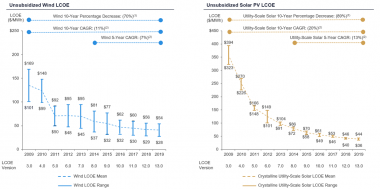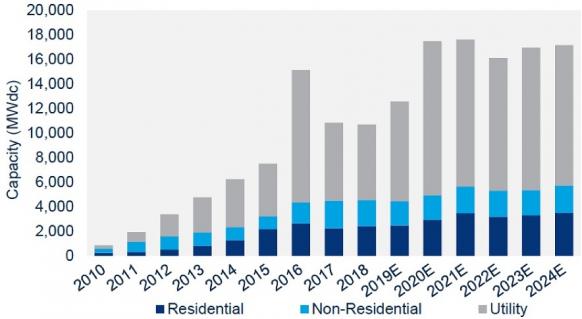PV plant costs fall 7% to threaten coal units; US court temporarily halts bifacial tariffs
Our pick of the latest solar news you need to know.

Related Articles
Falling solar, wind costs pressure US coal, nuclear fundamentals
Average costs for utility-scale solar plants have fallen by around 7% in the last 12 months, increasing the competitiveness of solar facilities against existing conventional U.S. plants, Lazard consultancy said in its 'Levelized Cost of Energy Analysis Version 13.0' report, published November 7.
Lazard estimates utility-scale solar costs at $36/MWh-$44/MWh for crystalline technology and $32/MWh-$42/MWh for thin-film plants. Onshore wind costs are estimated at $28/MWh-$54/MWh, down by around 4% since the same time last year.
Including U.S. government subsidies, the average cost of building new utility-scale solar is estimated at $36/MWh with onshore wind at $28/MWh, Lazard said. Both technologies are competitive with the marginal cost of coal and nuclear generation, estimated at $34/MWh and $29/MWh respectively, it said. The cost of new gas-fired plants was estimated at $44/MWh-$68/MWh.
Cost reductions for solar and wind are slowing as these technologies mature, Lazard noted.
Over the last five years, utility-scale solar costs have declined by 13% on average, compared with 7% for onshore wind, it said.
Levelized cost of wind, solar plants
(Click image to enlarge)
Source: Lazard's 'Levelized Cost of Energy Analysis Version 13.0' report, November 2019.
PV and wind plants need energy storage to truly match the dispatch capabilities of conventional generation.
PV plus storage costs are continuing to fall as the cost of lithium-ion batteries drops on the back of improving technology and a maturing supply chain, Lazard said.
Utility-scale PV plus storage costs are estimated at $102/MWh-$139/MWh for 50 MW plant with 200 MWh of storage, it said.
"Solar PV plus storage systems are economically attractive for short-duration wholesale and commercial use cases, though they remain challenged for residential and longer-duration wholesale use cases," Lazard said.
US court gains temporary reprieve to bifacial buyers
The U.S. Court of International Trade (CIT) has temporarily halted a move by the Trump administration to remove import tariff exemptions for bifacial solar panels, according to media reports.
In October, the U.S. Trade Representative (USTR) reversed an earlier decision to exempt bifacial solar panels from Section 201 import tariffs.
Following challenges by solar industry participants, the CIT imposed a temporary restraining order on this reversal on November 7, effective until November 21.
"This is a very positive development for the industry, but it is only the beginning," the Solar Energy Industry Association (SEIA) said in a note published by Solar Builder.
The CIT will hold a hearing on a preliminary injunction before an expected decision on whether to block the USTR's revocation, SEIA said.
Last month, the USTR said the exemptions for bifacial panels would undermine the objectives of the Section 201 safeguards.
Demand for bifacial panels is soaring as operators seek higher yield to combat intense market competition. Bifacial plants can increase output by several percentage points, at relatively little extra cost.
In September, Wood Mackenzie Power and Renewables forecast U.S. bifacial installations will hike from 500 MW in 2019 to over 2 GW in 2020, boosted by the earlier tariff exemption. By 2024, U.S. bifacial installations could hit 7 GW per year, it said.
US PV installation forecast
(Click image to enlarge)
Source: Wood Mackenzie Power and Renewables, September 2019.
In October, SEIA warned the USTR's exemption reversal would "slow the growth of an American economic engine."
US pledges $98 million to PV research
The U.S. Department of Energy (DOE) is to provide $98 million of funding to 62 research projects that help reduce solar PV costs and improve grid integration, the DOE announced November 6.
In its latest solar funding round, the DOE will provide $23.6 million to 21 PV research projects that will improve performance, cut material and manufacturing costs, and improve the reliability of PV systems. Some $17.6 million will be provided to 19 research projects that reduce soft costs such as administration fees and regulatory burdens. A further $6.8 million will be channelled into seven innovative manufacturing projects.
In addition, some $50 million will be provided to 15 research projects that help grid operators accommodate growing solar penetration, the DOE said.
"These projects also support development of technology solutions that enhance the visibility and control of PV inverters and sensors, while improving the security of those devices from cyber attack," it said.
The department also pledged $30 million to 13 concentrated solar power (CSP) projects. These projects will help the U.S. achieve the DOE's CSP generation cost target of $50/MWh by 2030 for CSP with a minimum 12 hours of thermal energy storage, it said.
New Energy Update


